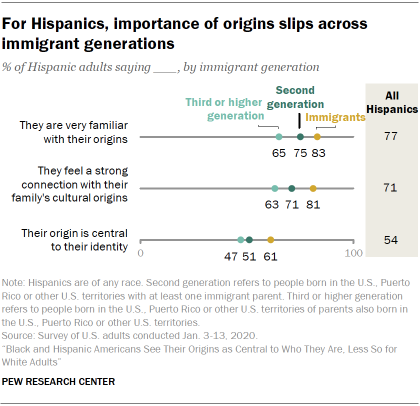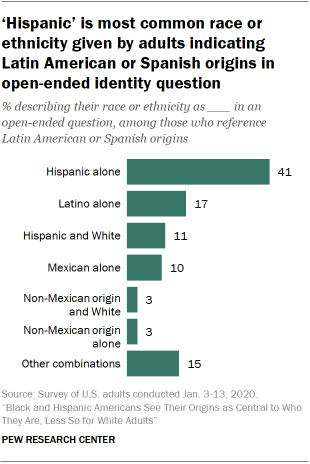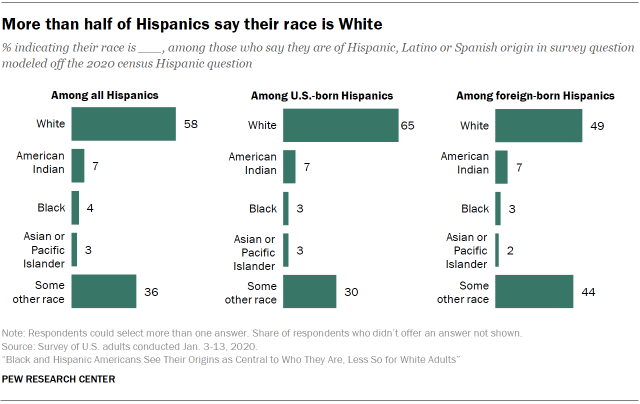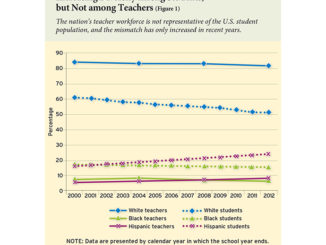
There are many ways to ask about racial and ethnic identities or origins. The choices that Hispanics make to describe their racial or ethnic identity can vary depending on how the question is asked and who is asking it.
For U.S. Hispanics, racial and ethnic identity can have many dimensions. Nearly two decades of Pew Research Center surveys of Hispanics show some identify most often with the country of origin of their ancestors, such as indicating they are Mexican, Dominican or Cuban or even American. Others choose pan-ethnic identities like Hispanic, Latino or even Latinx.
For others, their Hispanic identity is part of their racial identity. Others may indicate they have a Hispanic ancestor, yet they do not self-identify as Hispanic. Across all these findings, a consistent pattern emerges: The more generations removed someone is from their family’s immigrant roots, the less likely they are to identify with the origins of their immigrant ancestors, or even to identify as Hispanic.
Overall, 77% of Hispanics said they were very familiar with their origins, according to the 2020 survey. This share varied by immigrant generation, though majorities of all groups said they were very familiar with their origins. Some 83% of immigrant Hispanics said they were very familiar with their origins, a higher share than among second-generation or third- or higher-generation Hispanics. Still, Hispanics across all three generations were more likely than White adults (54%) to say they were very familiar with their origins. And immigrant Hispanics were more likely than Black adults (59%) to say this.
The majority of Hispanics also feel a strong cultural connection to their family’s origins. About seven-in-ten Hispanics (71%) said this in the survey. Among immigrants, 81% said they felt a strong cultural connection to their family’s origins, a higher share than that among second-generation (71%) and third- or higher-generation (63%) Hispanics. All three groups of Hispanics were more likely to say they felt strong cultural connections to their family’s origins than White adults (36%). And immigrant Hispanics were more likely than Black adults (61%) to feel strong family cultural connections.
Hispanics are more likely to be immigrants than non-Hispanics. Some 45% of Hispanic adults were born in another country, while 11% of non-Hispanic adults were born outside the U.S., according to Pew Research Center tabulations of the 2019 American Community Survey.
While many Hispanics said they are familiar with their origins, only 54% said their origins are central to their identity. Here too there is a link to immigrant generations. About six-in-ten immigrant Hispanics (61%) said their origins are central to their identity, while 51% of second-generation and 47% of third- or higher-generation Hispanics said the same. By comparison, 55% of Black adults indicate their origins are central to their identity, and just 23% of White adults say so.
Hispanics and their race and ethnicity
There are many ways to ask about racial and ethnic identities or origins. The choices that Hispanics make to describe their racial or ethnic identity can vary depending on how the question is asked and who is asking it.
The open-end approach to asking about race and ethnicity
In an open-ended question asking respondents to describe their race or ethnicity, 11% of U.S. adults mentioned an origin with roots in Latin America or Spain. These responses included pan-ethnic terms like Hispanic, Latino and (less commonly) Latinx. They also included references to countries, like Mexico or the Dominican Republic.
Among these adults, the single most common response was Hispanic. Some 41% described their identity this way with no mention of other origins or backgrounds. Another 17% wrote Latino but with no mention of other identities or origins; 11% described their race or ethnicity as “Hispanic and White,” and 10% wrote Mexican as their race or ethnicity with no other origin mentioned. These responses in total accounted for about eight-in-ten (79%) of open-ended answers given by adults who indicated an origin in Spanish-speaking Latin America or Spain.
“Hispanic” was mentioned alone or along with other races or origins in 58% of responses that referenced some Latin American or Spanish origin, mostly without the mention of any other identity. Meanwhile Latino was mentioned in 25% of responses and White was mentioned in 19%.
The 2020 decennial census approach to asking about race and ethnicity
Later in the survey, respondents were asked about their Hispanic and racial identity in the format used by the Census Bureau in the 2020 decennial census. First, respondents were asked if they were “Hispanic, Latino or of Spanish origin” and instructed to write in their origin. Overall, 16% of survey respondents self-identified as Hispanic, Latino or of Spanish origin, a higher share than the 11% who indicated a Latin American or Spanish origin in the open-ended question about race and ethnicity. Notably, two-thirds (67%) of survey respondents who say they are Hispanic in the Census Bureau question also provided a Latin American or Spanish origin in the open-end, but one-third (33%) did not.
Second, respondents were asked their race and instructed that for the purposes of the race question, “Hispanic origins are not races.” Respondents could select more than one race. Among self-identified Hispanics, 58% indicated their race is White (either alone or along with other races), 36% indicated “some other race,” 7% indicated American Indian or Alaska Native and 4% indicated Black or African American (also either alone or along with other races).6
Responses to the Census Bureau race question varied by immigrant generation among self-identified Hispanics. About half (49%) of Hispanic immigrants indicated their race is White, a share that rose to about two-thirds among second- and third- or higher-generation Hispanics. Similarly, the share that indicated their race is “some other race” varied across immigrant generations: 44% of immigrant Hispanics indicated their race as some other race, while 30% of second-generation and 25% of third- or higher-generation Hispanics did so.
Among Hispanics, matches and mismatches in responses about race and ethnicity
Because the survey asked about race and ethnicity in two ways, it is possible to compare responses to the open-ended question with those of the closed-ended Census Bureau two-step question.
According to the survey, responses to the two methods for asking about race and ethnicity did not always match. Some 53% of self-identified Hispanics (based on the 2020 census Hispanic question) gave an answer in the open-ended question about race and ethnicity that matched what they indicated in the two-step closed-ended decennial census question, among those who gave valid answers to both questions. However, for 47%, there was not a complete match.
Similarly, among the 11% of adults who described their race or ethnicity in the open-ended question as indicating a Latin American or Spanish origin, 59% of responses matched selections in the decennial census two-question race and ethnicity method. Another 41% gave open-ended responses that partially match responses to the two-question race and ethnicity method. Less than 1% of open-ended responses among those indicating a Latin American or Spanish origin did not match responses given to the two-question race and ethnicity method of the decennial census.
One possible reason for this mismatch of responses is the instruction in the Census Bureau’s race question – for the purposes of this question, Hispanic origins are not races. Survey respondents may have been following those instructions, resulting in different responses in the race and ethnicity open-end question and the Census Bureau’s two-question race and ethnicity format.
While it is not clear which method is best or why there is a mismatch in responses among Hispanics, the survey did ask respondents about how well the Census Bureau’s two-question race and ethnicity method reflects their identity. About three-quarters (77%) of Hispanics said the census two-question method reflects how they see their identity and origins “very well” (44%) or “somewhat well” (32%), while 23% said it reflects their identity and origins “not too well” (17%) or “not at all” (5%). Immigrant Hispanics were more likely than U.S.-born Hispanics to say the census race and ethnicity questions reflect how they see identity and origins “very well” – 52% versus 38%.
Read Full report >>
.






